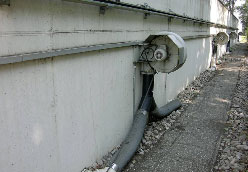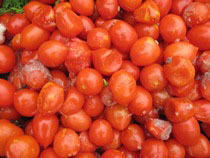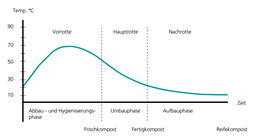Composting

Aerobic composting
Composting is the oldest recycling methods in the world for organic waste and has been used since ancient times by the Romans. In the aerobic composting soil organisms decompose organic waste using oxygen. It mainly produce carbon dioxide, water, heat and a humus-like decomposition products which we are used as fertilizers. Decomposition accomplish soil microorganisms (eg. As fungi, bacteria) and soil animals (eg. earthworm).
Stages of composting
Stage 1: Intensive or Pre-rotte: Splitting and mineralization of easily degradable organic substances (eg. sugar, starch, hemicellulose). Intensive bacterial activity with high metabolic rate. Mesophilic bacteria break down the organic matter. The temperature in the compost rises, thermophilic bacteria take over the work. Temperature to about 65°C.
Stege 2: Main-rotte: Degradation of complex organic substances (eg. lignin, cellulose). Actinomycetes, molds and yeasts with a lower metabolic activity. Temperature 50 to 25°C.
Stege 3: Post-rotte : Production of humic acid and clay-humus complexes. Mesophilic bacteria, actinomycetes, invertebrates. Temperature drops to below 20°C.

Why measure oxygen?
The oxygen measuring system MF-Oxy-Comp reliably measures the oxygen concentration in compost and regulates the ventilation of the rotting material during the intensive composting by means of a downstream user control and ventilation system. This is important because there is not enough oxygen for aerobic decomposition of the rotting material available, the bacteria population will switch to an anaerobic reduction program.
Therefore, oxygen measurement, because:
- This is sufficient oxygen for the complete and rapid aerobic implementation available;
- the energy consumption of the fan is as low as possible and
- the loss of water in the rotting material minimal.
- The time-consuming and costly conversion of the rotting material is omitted,
- it incurred significantly less unpleasant odors.

Why measure temperature?
The temperature measuring system MF-Temp-Comp reliably measures the temperature profile of the compost.
- The temperature profile provides information about whether: (1) the optimal ambient temperature is reached for the microorganisms during the intensive rotting and (2) ensuring sanitization of the compost is likely.
- So are the Biowaste Ordinance (BioAbfV, BGBI. I Nr. 65, 28.09.1998, p 2955) for the indirect process of sanitizing a continuous testing possible temperature measurement with automatic recording before.
- Also specifies the BioAbfV that the rotting material at least for two weeks 55°C or more than a week 65°C should be warm.
| MF-Oxy-Comp see product |
The oxygen sensor MF-Oxy-Comp (insertion probe) reliably measures the concentration of oxygen in the compost and regulates the ventilation of the rotting material during the intensive composting phase by a downstream control and ventilation system, installed by the user. | |
| Application: | Composting | |
| Measuring range: | 0.1 - 25 vol% O2 | |
| MF-Temp-Comp see product |
The temperature sensor MF-Temp-comp (insertion probe) determined with the help of five measurement points, the temperature profile of the compost. | |
| Application: | Composting | |
| Measuring range: | 0°C to +100°C | |



